Learn what small businesses are doing now and what analysts predict digital business transformation will look in 2021.

In December 2019, Gartner published a report recommending that to build and expand a digital business, businesses should “prepare for a complete retooling and skills renovation in the next five years (full report available to Gartner clients)."
Then the pandemic hit. The digital business transformation we expected to see happening over years is now happening within several short months. But what exactly does this look like?
We surveyed 406 small-business leaders to understand how they’ve pivoted their digital transformation strategy since the start of the pandemic; 68% of respondents said they now mostly or fully operate virtually in response to social distancing requirements.
In this report, we’ll pair our findings on how small businesses are making these changes with recommendations to help you do the same, as well as predictions for the future.
Customer retention takes center stage in business marketing strategies
Our prediction:
In 2021 businesses will double down on digital marketing efforts focused on customer retention.
Here’s a wild number for you: 21% of small businesses are fully digitized. At the end of 2019, that number was three percent. Digital business transformation is here, and businesses are having to reassess their digital strategies at lightning speeds.*
In Capterra’s July 2020 digital transformation survey of over 400 small-business owners, respondents cited customer retention as their top short-term and long-term business goal. Customer retention was ranked over increasing cash flow, cutting costs, and finding new customers.
This is a good indication that business owners understand how valuable loyalty is in their customer base, especially during an economic downturn. In times of uncertainty, people are less likely to take risks and try new things, which means the likelihood of attracting new customers is lower than usual.
These priorities (retention, cash flow, and limited spend) all benefit from an agile, customer-centered digital strategy that focuses on getting the right messaging in front of the right customers at the right time.
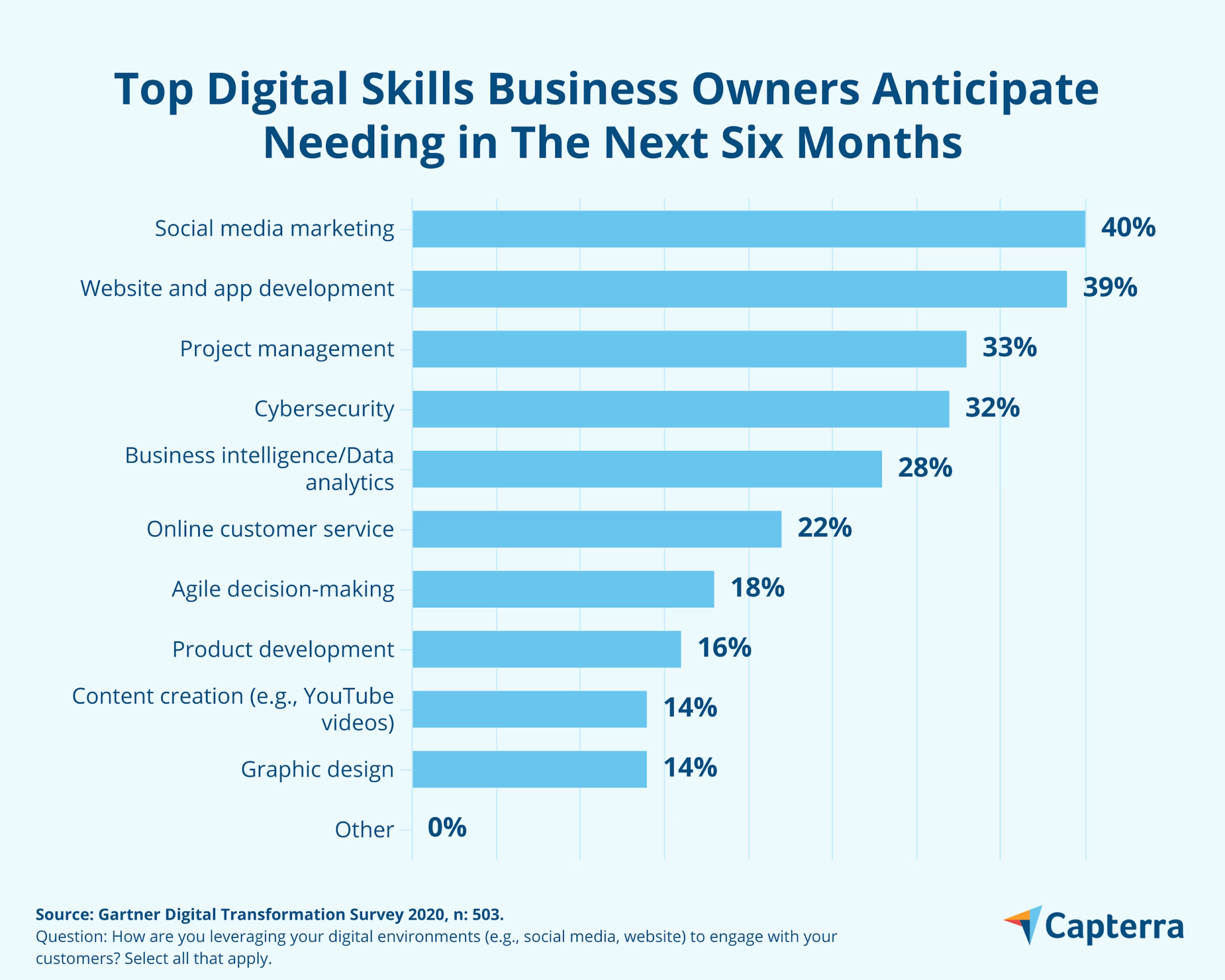
Three out of four business owners don't feel they're successfully leveraging their digital environment. If you're one of them, focus on building up your presence on social media and ensuring your website and mobile apps are as helpful and user friendly as possible (both excellent strategies for customer retention)
For a deep dive into these strategies and others, check out our full report on how to prioritize customer retention in your digital strategy.
Shifting internal business operations online is bittersweet: Advice from your peers
Our prediction:
By prioritizing business digitization, businesses will engage more effectively with both customers and employees.
When 48% of our survey respondents reported that shifting internal processes (e.g., employee performance reviews) online was moderately challenging, we wanted to know more.*

We interviewed small-business owners about their experiences making this shift, and asked what functions they’ve moved fully online and what challenges (and positives) arose along the way. Here’s what they said.
Your peers say: Performance reviews are more engaging online
Traditionally, when it came time for regular performance reviews, employees, their manager, and an HR team member all gathered to discuss the employee's performance. But meeting in the same room for a face-to-face discussion is no longer required, or the norm. And this change offers real benefits that go beyond health and safety.
Dan Bailey, president of Wikilawn (an online resource for local lawn maintenance professionals), said that taking a blended approach for virtual meetings and direct messaging has made employee reviews easier to schedule and more engaging.
Incorporating informal chats via Slack provides employees with the opportunity to ask and answer questions. “This gives everyone a chance to think about what they want to say and to better analyze the information given.”
Scheduling an online meeting has been easier than coordinating in-person reviews, too. Bailey says: “It used to be a big hassle for everyone involved, but doing it this way is easy to coordinate and only requires a short block of time for the Zoom meeting, then a commitment to interact in chat for the rest of it.”
Your peers say: Administrative software tools require time for onboarding
Going fully digital for some businesses can include shifting functions to virtual assistants or business process management software to help manage a fully remote business’ administrative tasks. But this shift isn’t always an easy one.
Tina Willis, a personal injury lawyer at Tina Willis Law, experienced unexpected issues shifting specific things like password sharing and project delegation online.
Password protection is critical to maintain the security of online accounts, but there are times when someone on your team needs access to your account (Willis cited uploading YouTube videos and allowing access to documents in her DropBox account as examples).
Password management software (such as LastPass, which Willis uses) can help, but these solutions don't always integrate with every other system or tool your business uses.
Willis said that the learning curve of using software for administrative tasks is challenging. When you implement a new tool for admin duties like these, don’t hesitate to ask the vendor for support to shorten the learning curve as much as possible.
Your peers say: Hiring and onboarding remotely supports a healthy workforce
In our individual contributors survey, half of employees (51%) said they want the option to work remotely, permanently.** But the question remains if businesses are ready for this, too. One way to help get your organization on board is to streamline and improve the onboarding process—new employee onboarding, that is.
Rex Freiberger, CEO of online publication Gadget Review, has found ways to make the entire interview and onboarding process entirely remote. While the company was accepting online applications and did follow-ups via email before the pandemic, they shifted the rest of the process online as well. Freiburger says that online meeting software, which allows real-time responses, is a crucial part of finding the right person for the job.
Freiberger says “When it comes to assessing content creators, we'll meet internally via a Zoom chat and review everything in real time to give our raw reactions. If we like their work, we invite them to a Zoom interview with myself and their department lead if applicable, as well as a senior employee who does the same kind of work they'll be expected to do.”
A deep dive into digital transformation for manufacturers
Our prediction:
Manufacturers that embrace digital selling and marketing right now will gain a significant competitive advantage over the next 12 months.
As an immediate impact of COVID-19, manufacturers had to significantly cut down their production capacity. After an extended period of losses, manufacturers are desperate to get back on track. In our small-business leaders survey, 48% of manufacturers cited retaining customers as one of their top three priorities, and 44% cited increasing cash flow.*
Customer expectations, preferences, and needs have changed dramatically in response to pandemic-induced social distancing requirements. More than ever before, customers want to engage and buy virtually, forcing manufacturers to digitize their operations. In fact, 61% of manufacturing respondents say they are conducting most of their business digitally, and 11% are conducting business entirely online.
When customers want to browse and buy online, it becomes mandatory for manufacturers to offer their products across all major digital channels. To make up for the loss of their traditional, in-person customer base, manufacturers are aggressively pushing to acquire new customers through digital marketing channels; 72% of survey respondents say they are using digital channels such as social media to promote their products.
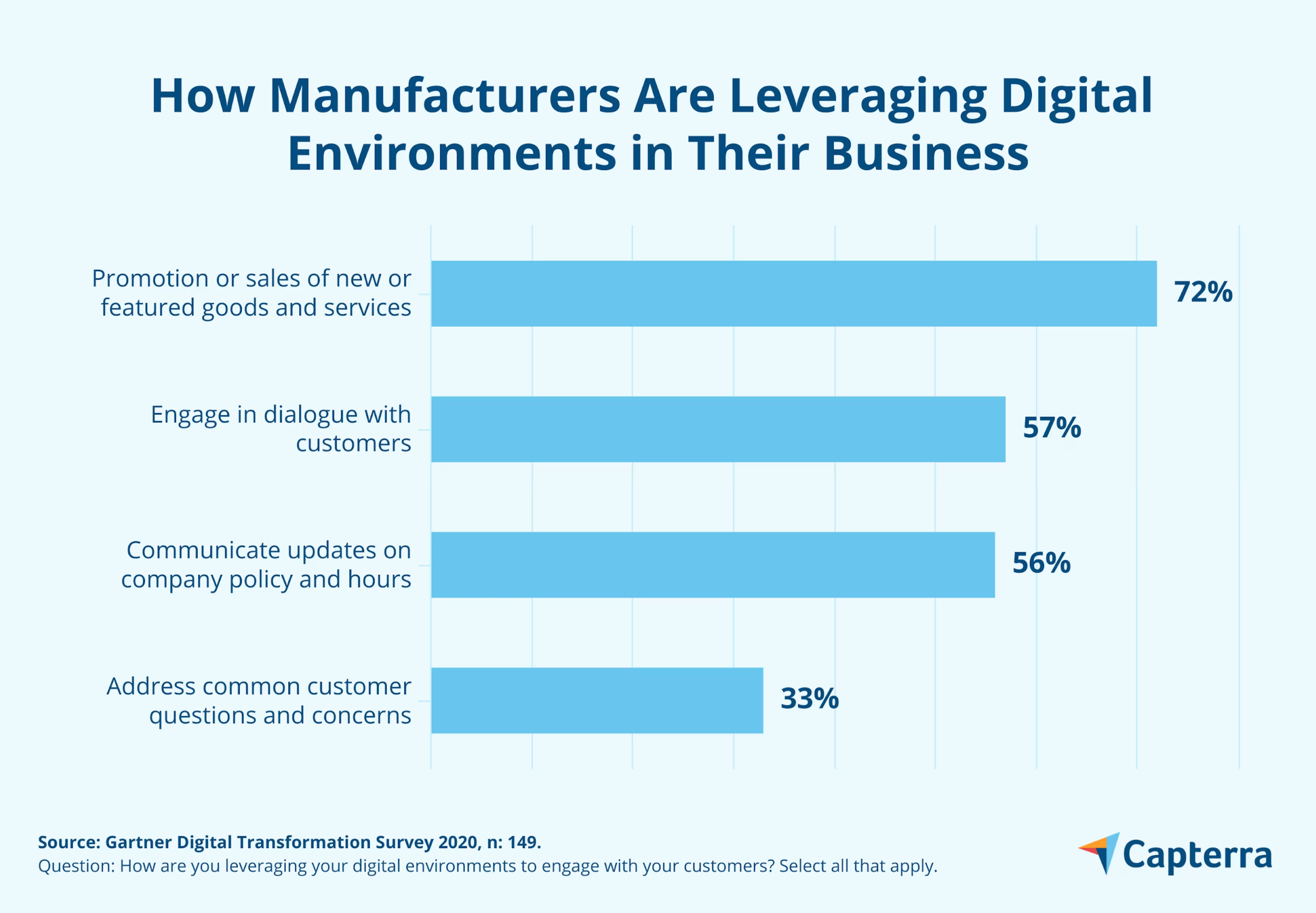
The biggest priority for manufacturers is to ramp production back up to pre-COVID levels. To do so, manufacturers will need to find new customers by investing in digital channels such as content marketing and eCommerce to sell their products.
Early adopters of this shift show promising results; 98% of manufacturing respondents in our survey say digital environments (such as social media) are successful in engaging customers.
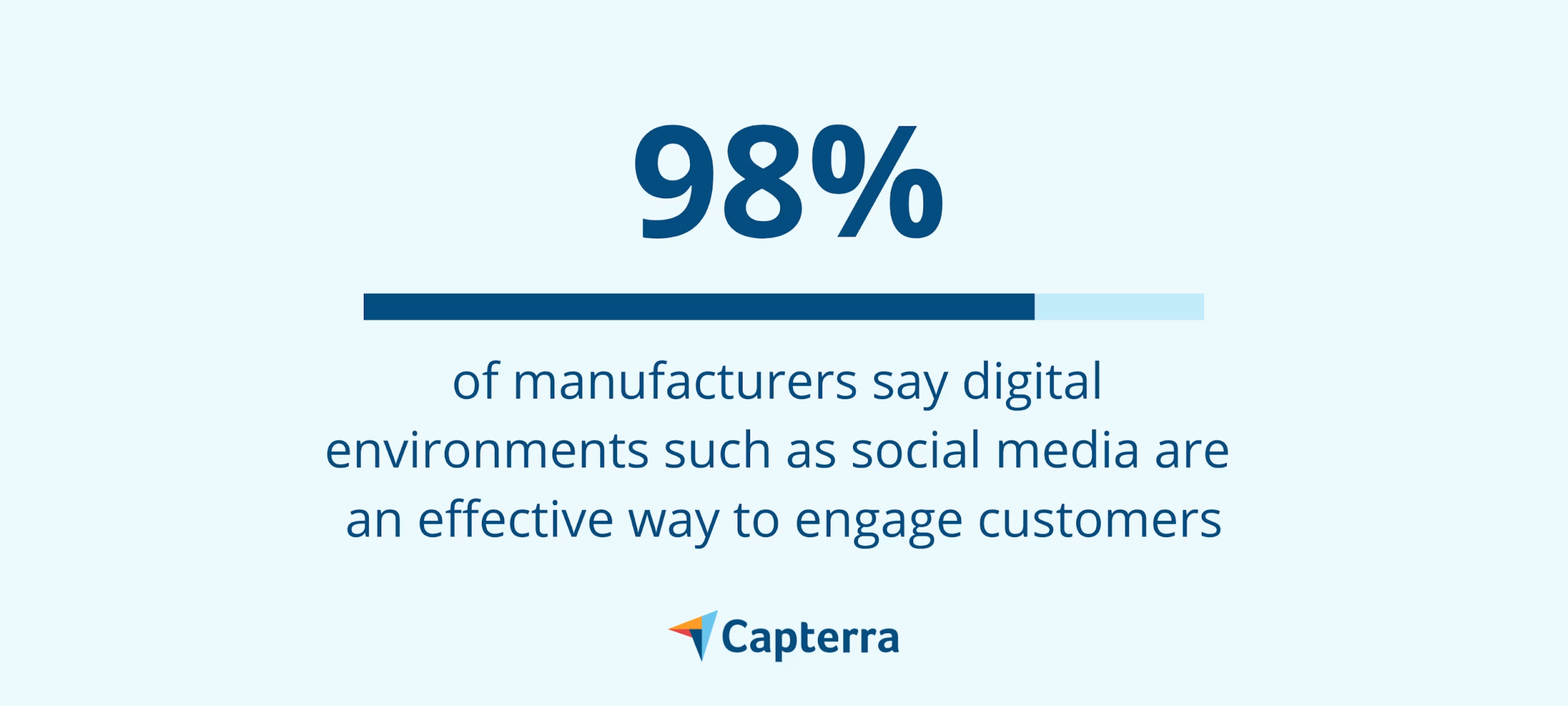
3 key digital channels that manufacturers are currently leveraging
Our small-business leaders survey identified three key digital channels that manufacturers are using to meet shifted customer preferences:*
Social media: When it comes to going digital, social media is one channel no manufacturer can ignore. Social media enables manufacturers to build an online community of interested buyers, and share company and product updates.
eCommerce: Prior to the pandemic, only 23% of survey respondents working in manufacturing were using eCommerce solutions to sell their products. Today, a full 67% of manufacturers are using these solutions.
Websites: As the customer experience shifts to discovering products online, building an easy-to-navigate website is more important than ever. Since COVID-19, about 51% of manufacturers report an increase in traffic. Of this group, 49% say that half or more of this traffic growth came from countries where they hadn’t operated before. Consequently, demand for website building software has grown. While just 29% of respondents were using this technology pre-COVID, 65% are using it now.
Want to learn more about how to implement new digital marketing channels at your manufacturing business? Read: "How Digital Marketing Can Help Manufacturers Survive in a Pandemic-Hit Market."
Small businesses are underestimating the long-term use of software
Our prediction:
By the end of 2021, small businesses will still be using software originally purchased for only temporary use.
Investing in software to support a digital business model is cited by over half (56%) of small-business owners as their top strategy for staying competitive since the start of the pandemic.* When asked about their planned use for purchased software, we noticed a lack of awareness of both the long-term need and benefits of this software.
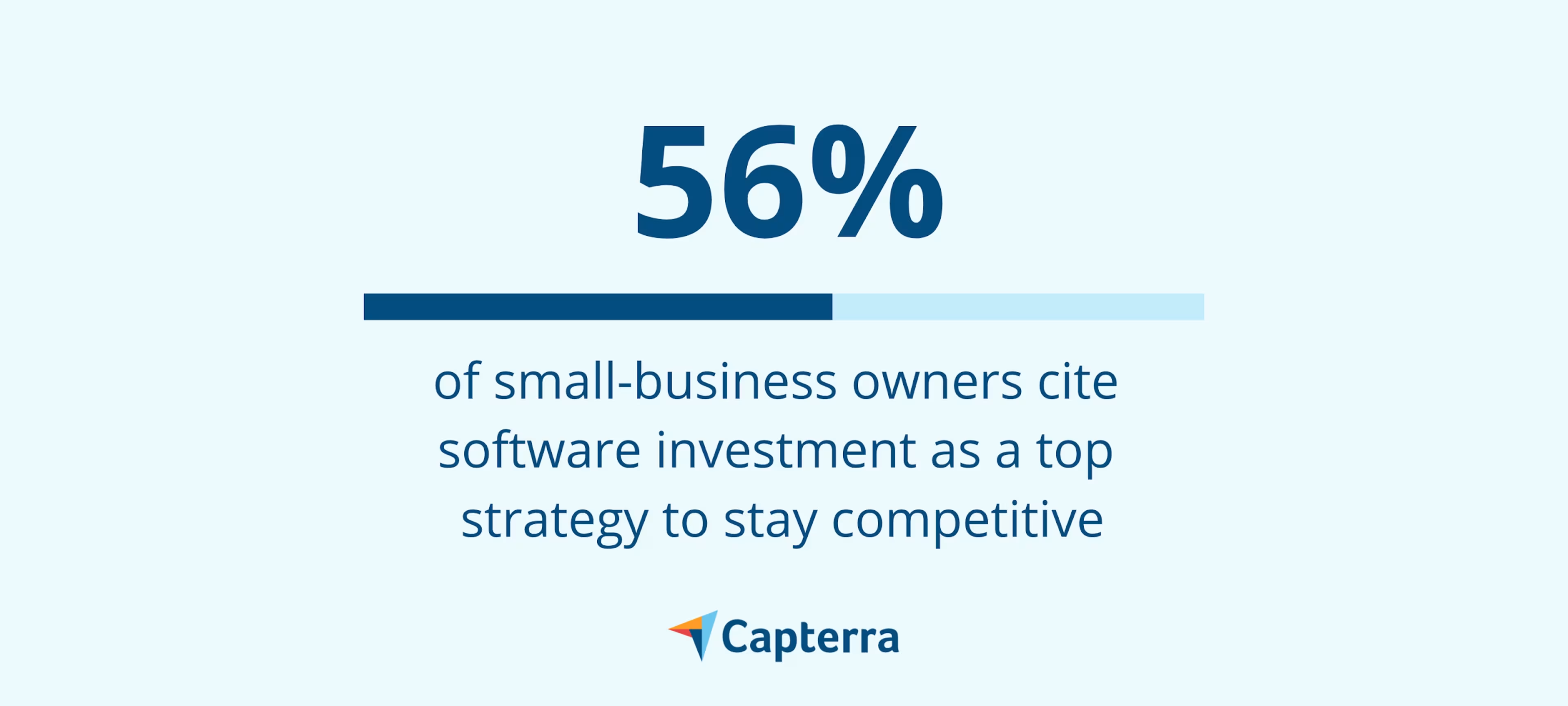
When asked which software is the most critical for going digital over the next 12 months, online meeting software took the top spot for half of respondents. As an immediate response to social distancing guidelines, this makes sense. As a long-term investment, should this be where small businesses like yours put their money?
Let’s take a look at how your peers are using, and plan to continue using, software.
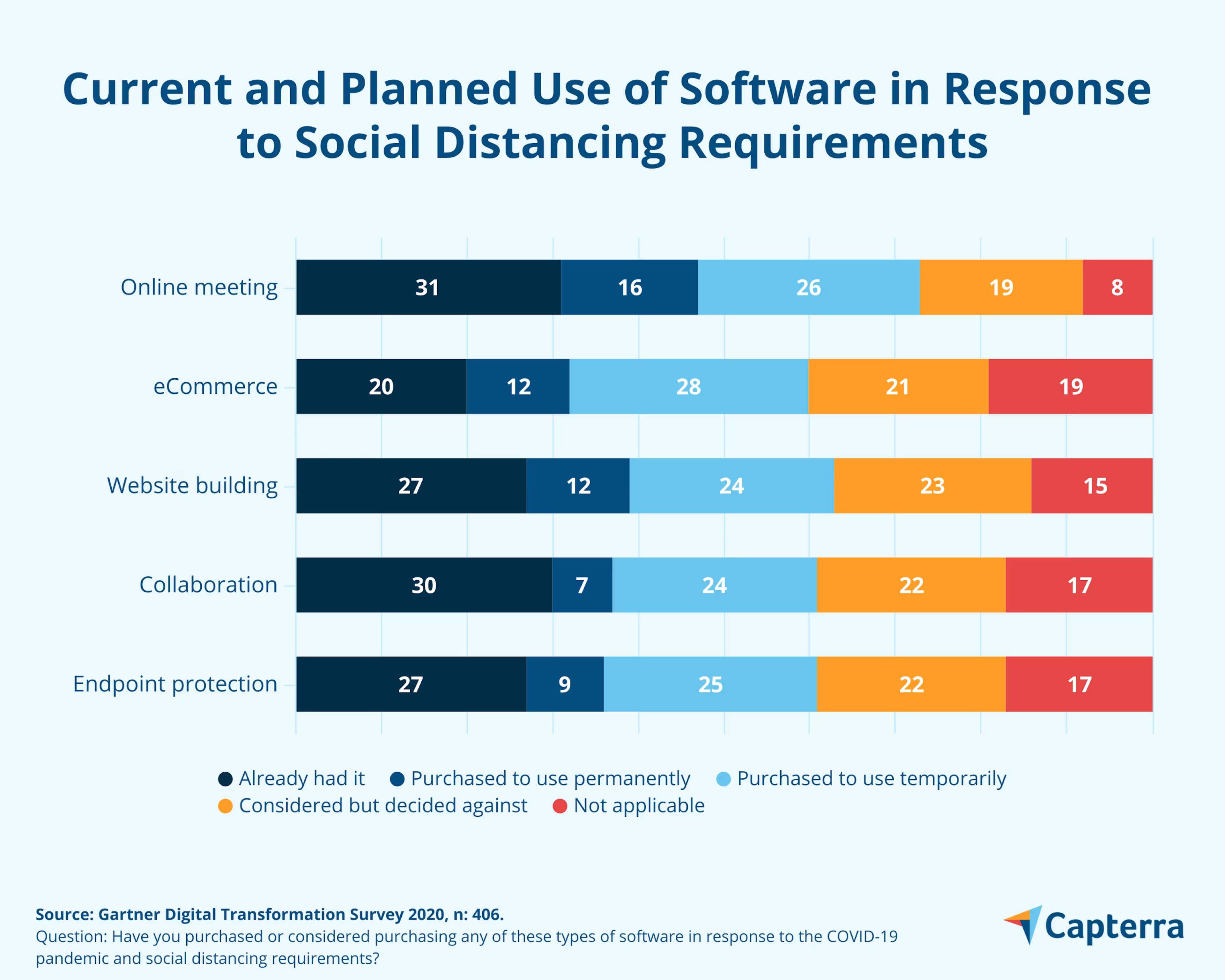
The key insight here is in the difference between the dark blue and light blue bars. The higher numbers for planned temporary use could mean small-business owners underestimate the long-term benefits of this software as they maintain COVID-induced digital transformation.
When asked how software has positively impacted their business, small-business owners cited facilitating remote operations (52%), increased productivity (50%), and improved customer engagement (49%) as the top three benefits. This indicates a clear understanding of immediate software benefits for organizational change, and left us thinking that it's the long-term benefits where leaders are tending to be short-sighted.
Take virtual meetings as an example. When we surveyed individual contributors about their use of online meeting software, over half report using it at least once per day.** That number jumps to 80% for at least weekly. Your teams are working efficiently as a remote workforce, and odds are good you’ll decide to keep them remote at least part of the time. This means online meeting software is a long-term success factor, not a pandemic bandage.
Software investments are not only supporting a remote workforce that may need (and want) to remain that way permanently, but also support digital revenue streams that will certainly prove beneficial in the long run.
If you’re among the small businesses planning on only temporary use of your new software, shift your thinking to how this digital technology is becoming critical to the long-term success of your business.
Start by asking your team which tools they’re using, and what features of those tools they use most often. From there, you can start building the costs of these tools into your annual budget now so you’re not struggling to find the money next year or the one after.
Thinking about hiring a full service digital agency for your business needs? Browse our list of top full service digital agencies and learn more about their features in our hiring guide.
A final thought and key takeaways for your digital transformation journey
Throughout this report, we’ve shared survey insights, digitalization trends predictions, stories from your peers, a deep dive for manufacturers, and a breakdown of how software is working to support these efforts.
That was a lot of information to take in, so we’ve boiled it all down to a final thought: Digitization will help your business weather immediate uncertainties while planning for the future.
To help you keep all this in mind, here's a summary of our predictions and need-to-know insights about the digital transformation landscape as you move into 2021, and beyond.
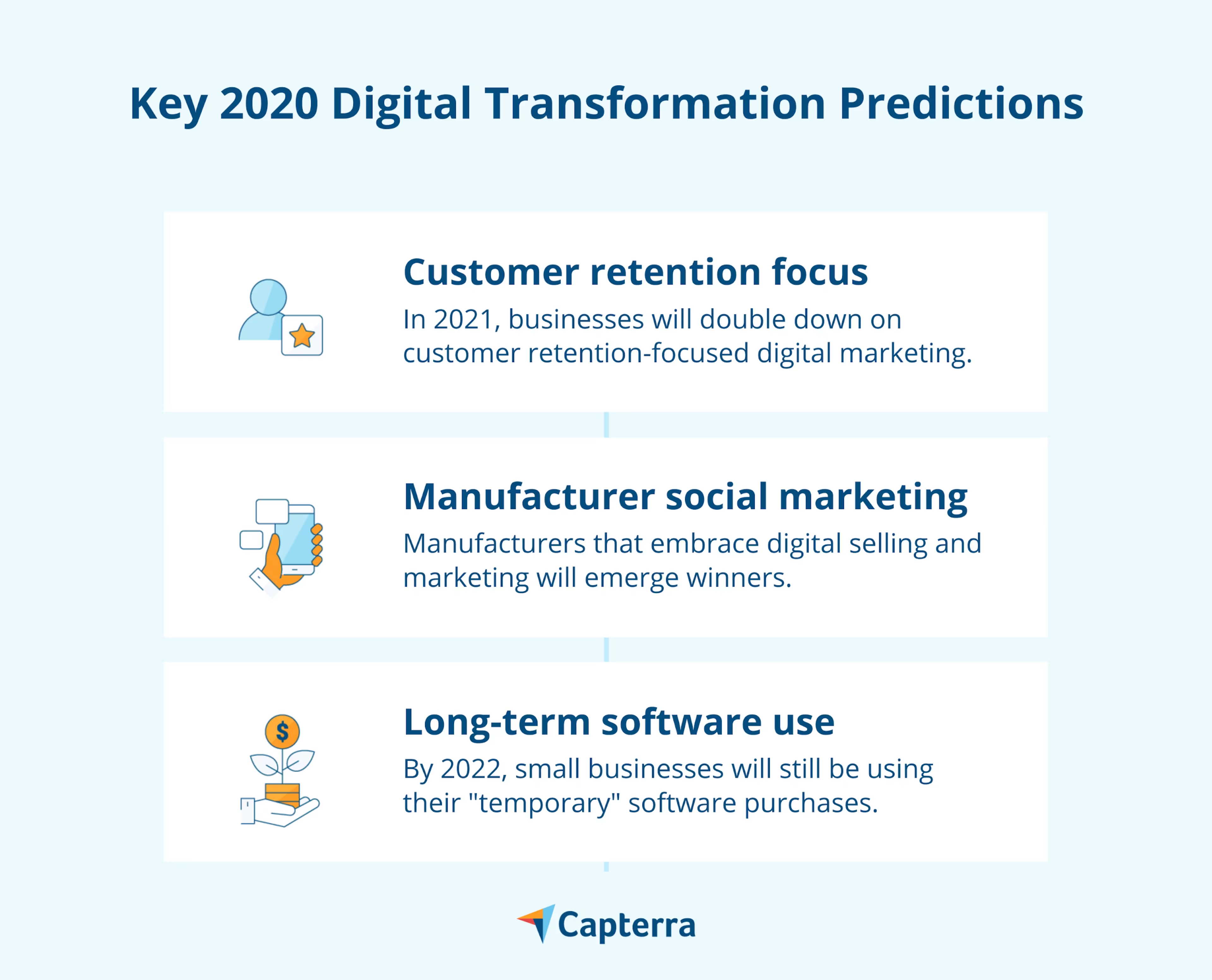
The innovation and grit found in small businesses will be the root of the success you find in your digital transformation. As your partner in a successful digital transformation, our recommendations, predictions, and insights are designed to support your business as you navigate this disruptive time.
Learn more about how your peers are going digital
Small-business owners share their stories about the challenges they’ve overcome as they take their businesses fully online.
